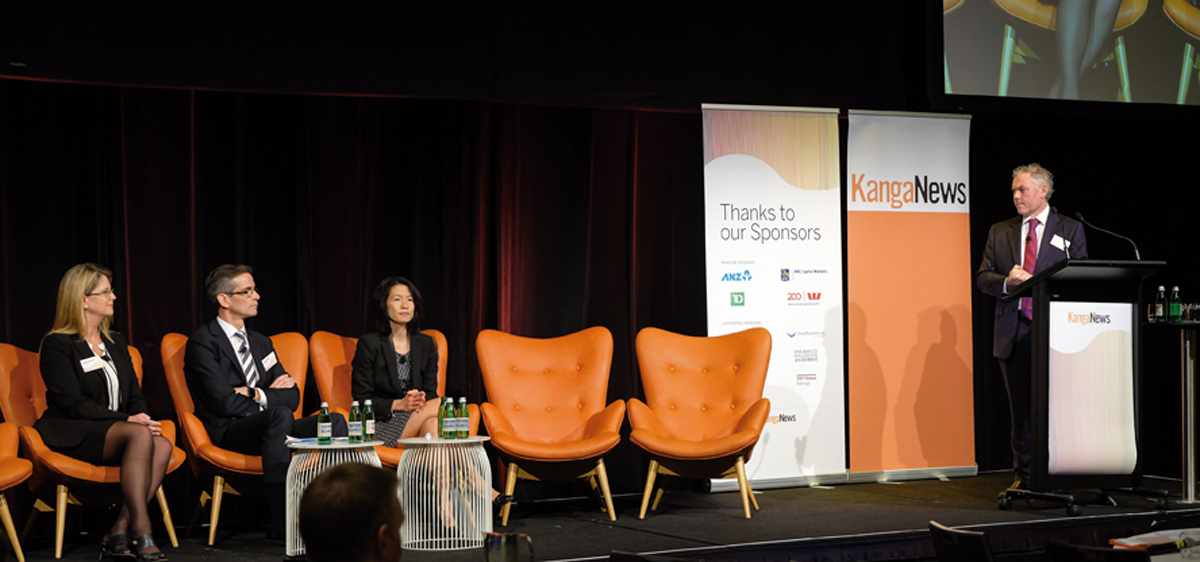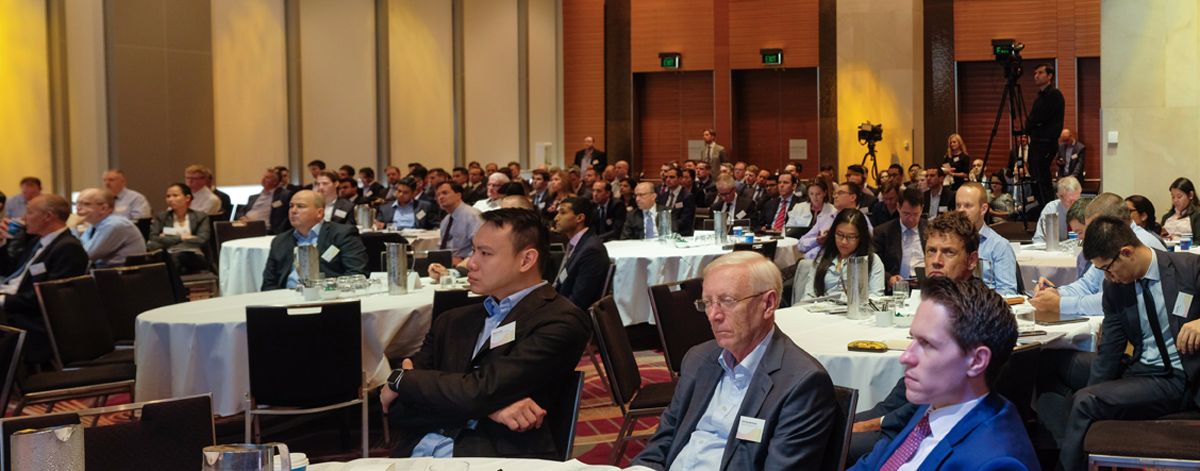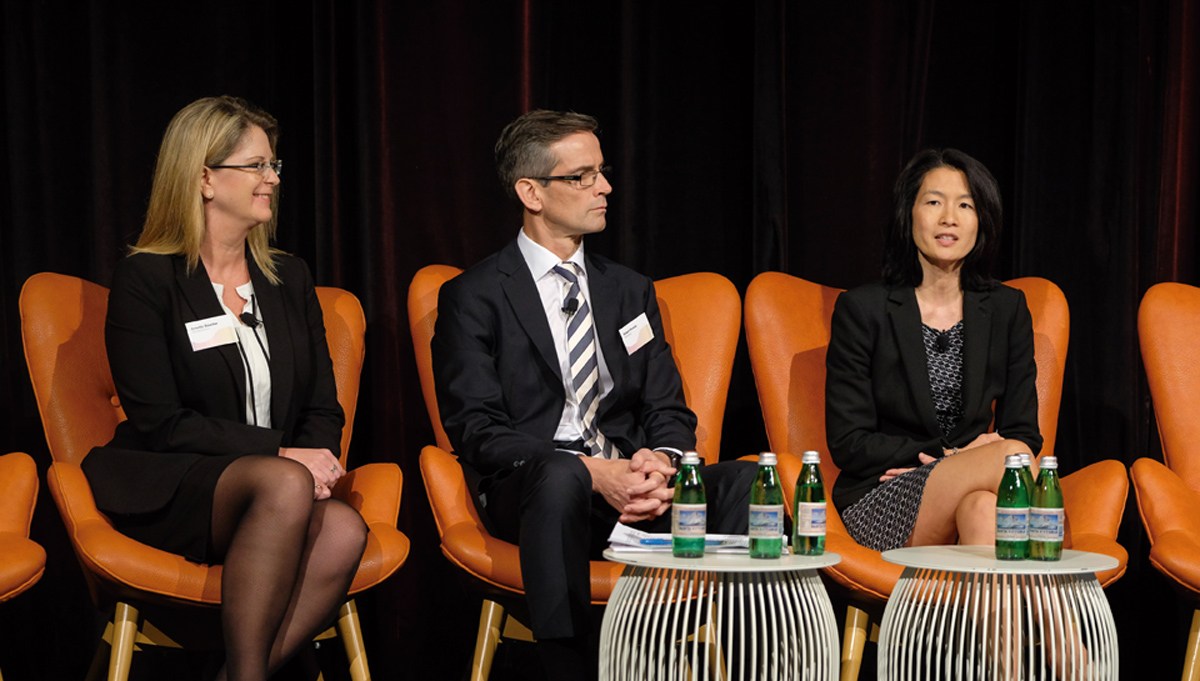
View from the summit
The group of leading market economists gathered at the KangaNews Debt Capital Markets Summit discussed what appears to be an increasing range of risk possibilities for global economies. US protectionism, trade wars, and the future direction of rates and bond yields were on the agenda.

US IN DEPTH
Redican Global growth is generally good in early 2018, but is this ‘five minutes of sunshine’ and can we dispel the notion of secular stagnation?
While there have been some very welcome changes on the cyclical side, like upgrades to growth and inflation, I still think the underlying issues in areas like labour markets are a long way from being resolved.
Redican The US is showing more vibrancy, with 20-year high consumer-confidence levels and the second-highest small-business confidence readings of all time. There is about to be major fiscal stimulus through increased spending, tax cuts and banking-sector deregulation. Will this lead to much stronger growth over the next 12 months in the US?
The combination of strong jobs growth, an unemployment rate below NAIRU [non-accelerating inflation rate of unemployment], underemployment being back to pre-crisis levels and early signs of a pick-up in wages bodes well for the consumer and the economy more generally.
We know the consumer has deleveraged over the last decade and is in better shape all round. We think this will contribute to the longevity of this growth cycle in the US.
Throw in the tax cuts, and our US team has lifted its growth forecast for this year and next by about a quarter of a point. We are looking for growth to step up to around 2.8 per cent this year and above 3 per cent next year.
Redican What does this mean for monetary policy in the US?
The US dollar weakened significantly last year and has continued to do so in 2018. Credit spreads have been very well behaved and while US interest and mortgage rates have kicked up higher the flattening of the curve has tended to shield the economy from moves in monetary policy.
We are still below levels that were prevalent at the beginning of 2016. Since then the Fed has raised rates five times and financial conditions haven’t tightened significantly.
What we are really watching is the extent to which the mix of financial conditions shifts through this year. As we get to the latter stages of 2018, bond yields should move higher and we will probably start to see some strengthening in the US dollar. I think tightening financial conditions is on the Fed’s radar. It was in the January minutes and [Fed chair] Jay Powell mentioned it in his semiannual testimony as well.
We have 10-year US Treasuries (UST) at 3 per cent by year end. This looked a certainty only weeks ago, but the market retreated quickly from this level. We are also cognisant of the fact that inflation disappointed on a couple of occasions last year. Nothing ever moves in a straight line.
We are calling for three hikes this year and three again next year, but we will only be pushed further when the data really surprises on the upside.
Redican Some members of the Federal Open Markets Committee (FOMC) suggest there shouldn’t be any more rate hikes in the near term. How is Jay Powell going to get consensus from the FOMC to escalate the pace of rate hikes?
I don’t mind that there is a diverse panel and the fact that different views are represented. Some looking for fewer hikes and others that are more aggressive is what makes a market. What’s key is that, realistically, Powell is still untested. We have heard him make the right noises so far, but we will see what happens at the next FOMC meeting.
Redican A strong academic framework and a focus on the Phillips curve were characteristic of the Fed under its last two chairs. The economy has exhibited a lack of inflationary pressure despite a very tight labour market, so is this framework still relevant?
There has been a structural shift, from a combination of automation, globalisation or demographics. But we know the shift has occurred and the curve is flatter as a result.
The theory remains relevant and it still guides a lot of central-bank thinking. This is evident with the Reserve Bank of Australia (RBA) – I don’t think it is prepared to give up on the notion that, eventually, market forces will work.
This said, the flatter curve has certainly come into discussions. It has made central banks cautious around policy normalisation – which is why it has taken a long time to come through.
Redican Where are longer-term bond yields in the US heading over the next year or two?
We think this, combined with the fact that the global central-banking stance in G7 countries is shifting towards removal of accommodation, will result in higher bond yields being led by the US over the next year or two. Our target for US 10-year yields by the end of this year is at 3.3 per cent. This steps up further to 3.75 per cent by the end of 2019.
Overlaying the historical expectation, our sense is that 3-3.2 per cent for the 10-year UST writes in a lot of the bad news. Granted, there are a lot more bonds coming and we know the Fed is buying less. Foreign central banks are doing the same as they go from quantitative easing to quantitative tapering. Obviously with the residential mortgage-backed securities pool owned by the Fed beginning to come off the balance sheet there is a bit more inherent volatility in bond markets as well.
We subscribe to the idea that the 30-year secular bond bull trend is over. However, my point of view is that it is difficult to see a global sell off in bond markets much beyond that 3-3.2 per cent level for now, given the global dynamics of low inflation and low wages.

The ECB surprised everyone recently by starting a tapering discussion. We thought this wouldn’t come until the end of the year, but now we are looking for a clear announcement of tapering at the June ECB meeting. If this happens the market may trade on the US-euro spread.
The BoJ has a bit of a scandal going on at the moment but while [prime minister] Shinzo Abe and [BoJ governor] Haruhiko Kuroda are at the wheel, we are confident the BoJ will begin a discussion on yield-curve control measures being reversed. It certainly won’t be just about the US in this space – it will be a global trade.
AUSTRALIAN OUTLOOK
Redican I would like to turn our attention to Australian rates and yields. How do panellists expect the RBA to enact policy over the next couple of years and what will happen with Australian bond yields compared with the steep rises in US bond yields?
We think the RBA will be lagging the global cycle of policy accommodation. This is mainly due to there being considerably more slack in the Australian economy than elsewhere. The unemployment rate is about 0.5 per cent above full employment and underemployment levels remain quite elevated. The spare-capacity story here is in marked contrast to the US.
There is a risk that we get one rate hike by late this year, though. If this happens we think it will be largely due to global factors and continued strong global activity.
In either case, there would be continued spread divergence for Australian bond yields. The 10-year Australian-US spread has already moved firmly negative in the last few weeks, trading as tight as minus 10 basis points. We think the risk for this is to move further negative, at least over the first half of this year, to around minus 25 basis points.
We have the RBA-Fed funds differential turning considerably negative over the course of this year, which will ultimately drive the 10-year benchmark spread. Our yields will get dragged higher, but not to the same degree as in the US.
Further into the year, as the market thinks about rate hikes from the RBA more consistently, we may see a bit of an unwind for that differential. It looks like we are in the territory of the 10-year Australian-US spread that we had in the late- 1990s and early-2000s.
We are still looking for one rate hike before the end of the year, though. I am of course aware of household indebtedness and spare capacity in the labour market. However, Canada is even more heavily indebted than Australia and that didn’t stop the Bank of Canada (BoC) from moving three times in six months.
I am supportive of getting rates off the floor and preparing for the next challenge. We don’t get this conversation much from [RBA governor] Philip Lowe, but [previous RBA governor] Glenn Stevens was dragged kicking and screaming to lower the cash rate below 2 per cent after we had the nasty inflation shock to the downside to 1.5 per cent from 2 per cent in 2015.
We now have inflation closer to 2 per cent so from my perspective it is off the floor. Wages are also off the floor, so it is time to start moving the cash rate. Everyone knows we have had a record monetary expansion, and if we don’t have enough bullets in the chamber we won’t have the capacity to deal with the next crisis should there be one.
Furthermore, when the BoC began its policy normalisation in July 2017 growth in Canada was running at about double that of Australia. Consumption in Canada was running at around 4 per cent and business investment was in the double digits. I think it was quite a different story despite the similarities around household debt.
When Australia is in a position of experiencing robust business investment, a stronger consumer and an unemployment rate that is close to NAIRU it will be a different story. I suspect Australia will continue to lag Canada in the rates cycle for the time being.
The dynamics for housing through this year also suggest continued softness. We have been hearing the word “gradual” a lot from the RBA, which is very much in line with our views.
RESERVE-BANK TARGETS
Redican Norway recently reduced its inflation target to 2 per cent from 2.5 per cent, which is an easy way to solve the problem if you can’t meet your target. There is a broad debate around inflation targeting, but should we consider different strategies for managing monetary policy?
I’m sure if we asked anyone at the RBA the same question they would say something similar – in other words that the system isn’t broken. The reserve bank has been very clear about flexibility around the band, so there doesn’t necessarily have to be a policy response whether we are at 1.5 per cent or 2.5 per cent.
On policy flexibility, I agree with Annette Beacher in the sense that the RBA has done a great job of highlighting the importance of flexibility. But I would point out that we have been below the floor of the inflation target for nine quarters now. There comes a point where we have to ask how flexible we want the RBA to be.
Protectionist policy
One of the X-factors markets have had to deal with recently is the prospect of protectionism in the US. There would clearly be consequences for the global economy – and for Australia – in such an environment.
BEACHER Tariffs were a Trump campaign special, so we weren’t too surprised. There had been relative silence on the subject and we thought we may have dodged a bullet. But it has now come back with a vengeance.
However, it has been noted by the international-investor community that Australia managed to escape the tariffs on steel and aluminium. The exemption gives Australia some status in the eyes of global investors.
I doubt there is a single person in the room who thinks trade wars are fantastic for growth, inflation, global trade or employment.
Redican The RBA has nominated 3.5 per cent as its estimate of the neutral cash rate in Australia. Is this a reasonable estimate, and do panellists think we will we see it reached in our lifetimes?
The structural issues around low wages have yet to be resolved, so I was quite surprised when the RBA came out with 3.5 per cent as its neutral cash-rate position. The Reserve Bank of New Zealand then came out and said its was the same. I think they are both too high and that 3 per cent or below would be more appropriate.
The Canadian experience will be telling as we go forward. The governor of the BoC has talked about the level of indebtedness and the odds that it will stop the bank moving towards an ‘old’ neutral level of 3 per cent. Canada is likely to stop well short of this, in a direct reference to the impact of highly indebted households, the transmission mechanisms and what these mean for the neutral cash rate.
EYES FRONT
Redican Where do panellists see potential shocks or surprises coming from over the next 12-18 months?
We have seen a bit more growth, inflation and volatility, and we opened limit-down on the US for a couple of mornings. However, this has already occurred, so I don’t think we could consider it a market shock if it happens again.
The proportion of global purchasing-manager indices rising in November 2017 was 94 per cent, but in February this year it was down below 50 per cent. I calculate a purchasing-power-parity, GDP-weighted global surprise index which includes 22 individual economies, and this peaked in October last year.
We come into this period of potential trade protectionism with growth at a cyclical high but lead indicators rolling over, and I think the risk is that potential volatility could begin to influence markets very quickly.
When you throw in protectionism, trade wars, dysfunction in the White House and the budgetary situation, what happens to the US dollar is key. I don’t think anyone anticipated it to be quite this soft given what is happening with growth and Fed funds. This potentially throws up some surprises around whether the Australian dollar may go higher than we all think, including on a trade-weighted basis. This may pose some challenges and surprises over the next 18 months.

Redican Where do you see the Australian-US dollar exchange rate going?
There has been a rebound in coal and iron-ore prices but, more importantly, there has been an increase in LNG export volume. Three new LNG trains were added in 2015, four in 2016, three last year and we have another four coming on stream this year.
You can make the argument that it is the shift in the savings-investment balance which is driving the current-account movement. Essentially, what this means is we need to find fewer foreign investors to fund the current-account deficit.
Another aspect that has emerged in the last couple of years is an excess of equity-related inflow into Australia. The current-account deficit was A$40 billion (US$30.8 billion) last year, while we had a net equity inflow of close to A$90 billion. In other words, Australia was significantly overfunding its current-account deficit through equity inflow in the form of infrastructure investment, asset recycling and outright equity issuance. I think these have been important contributors to a sticky Australian dollar.
The Q4 balance-of-payments data showed signs of softening in the equity inflow in the second half of 2017, which opens the way for some easing of the exchange rate. However, this analysis of capital flow suggests that we probably have a stickier currency than the interest-rate differential would suggest. This will be important from a domestic economic point of view.
My RBA view is a little bit different, with overnight-indexed swap flat at practically zero. With hikes priced in there is a bit of interest on this front. We have been US dollar bears for quite some time and for this reason a lot of my Australian dollar forecasts have been higher than those of my peers.

HIGH-GRADE ISSUERS YEARBOOK 2023
The ultimate guide to Australian and New Zealand government-sector borrowers.

WOMEN IN CAPITAL MARKETS Yearbook 2023
KangaNews's annual yearbook amplifying female voices in the Australian capital market.

SSA Yearbook 2023
The annual guide to the world's most significant supranational, sovereign and agency sector issuers.












